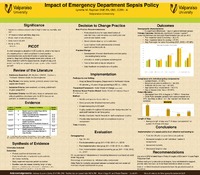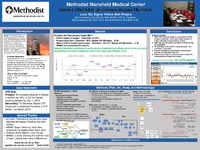| dc.description.abstract | <p>Session presented on Sunday, September 18, 2016:</p>
<p>Sepsis can be described on a continuum from initial infection to severe sepsis. It is a serious concern of key healthcare stakeholders due to high incidence, mortality, and cost. The objectives of this evidence-based project were to 1) identify potential sepsis patients early during the emergency department (ED) triage process and 2) implement Sepsis Order Sets. Kotter's change model and the Stetler model of evidence-based practice guided this project. An extensive literature search was undertaken to find best practice evidence regarding care of sepsis patients. Recommended care includes a protocolized format utilizing a screening tool and point of care lactate levels for early identification of sepsis, and early treatment with antibiotics and fluid resuscitation. A sepsis policy was developed that included use of a computer based triage screening tool, point of care lactate testing, and initiation of a Code Sepsis. Education of the ED staff was accomplished. Posters were developed and displayed throughout the ED and identification badge reminder cards were distributed. During the implementation period, electronic health records of all ED triage patients >18 years of age were monitored to measure staff compliance to the policy and its components. Additional outcomes of mortality and length of stay were also examined. A chi square test of independence was calculated comparing the screening rates pre and post policy implementation. A significant interaction was found (X2 (1) = 438.505, p<.001. Patients were more likely to be screened post policy implementation than pre implementation. Those patients screened in the post implementation group were analyzed for compliance with all components of the Sepsis Order Sets. These results include: 64% had a triage lactate drawn, 94.44% had blood cultures drawn prior to antibiotic administration, 52.94% had antibiotics initiated within 1 hour, 88.24% had appropriate fluids provided, and 64.71% utilized the computer order set. Secondary outcomes included a length of stay of 7.7 days and a mortality rate of 11.11%. An odds ratio was calculated in which patients were 34% less likely to die if screened than if not screened. Results demonstrate that the implementation of a sepsis policy that includes a computer based screening tool and triage lactate significantly impacts the early identification of sepsis patients and leads to timely treatment with subsequent decreased length of stay and mortality. These findings can be used to change current practice in both emergency department settings and in-patient units. Key Words: Emergency, Lactate, Protocol, Sepsis Screening, Sepsis Identification References Bastani, A., Galens, S., Rocchini, A., Walch, R., Shaqiri, B., Palomba, K., Anderson, W. (2012). ED identification of patients with severe sepsis/septic shock decreases mortality in a community hospital. American Journal of Emergency Medicine, 30, 1561-1566. doi:10.1016/j.ajem.2011.09.029 Dellinger, R., Levy, M., Rhodes, A., Annane, D., Gerlach, H., Opal, S.,?Moreno, R. (2013). Surviving sepsis campaign: International guidelines for management of severe sepsis and septic shock: 2012. Critical Care Medicine, 39(2), 165-228. doi:10.1097/CCM.0b013e31827e83af Kent, N. & Fields, W. (2012). Early recognition of sepsis in the emergency department: An evidence-based project. Journal of Emergency Nursing, 38(2), 140-143. doi:10.1016/j.jen.2010.07.022</p> | en |






